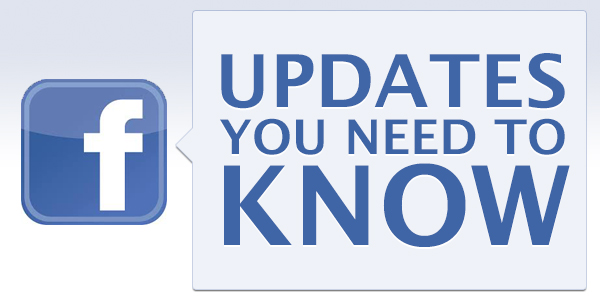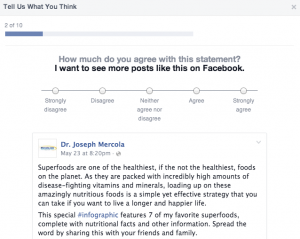Facebook News Feed Update!
Admit it, you get a little shiver of fear every time Facebook announces a tweak to their notorious News Feed algorithm. It’s okay to admit to it, a great many brands see the majority of their referral traffic coming from Zuckerberg’s social behemoth – it’s only natural to approach any change or tweak in their sharing system with a hint of trepidation.
Today, Facebook’s announced a new update to how the News Feed works, this time focusing on the strength of the signals which determine where stories rank in the News Feed for certain users. And it’s an interesting one – as explained by Facebook:
“The actions people take on Facebook—liking, clicking, commenting or sharing a post—are historically some of the main factors considered to determine what to show at the top of your News Feed. But these factors don’t always tell us the whole story of what is most meaningful to you.”
So if your engagement with on-platform content is no longer as strong a signal of personal preference, what then?
MEASURING QUALITY
In order to ensure the machine learning elements of Facebook’s News Feed algorithm are delivering the best possible experience for each user, Facebook also has an additional, human layer in their evaluation process – a group of testers they call their ‘Feed Quality Panel’. As reported by Time Magazine, the Feed Quality Panel is a group of users (more than a thousand of them according to Facebook) who provide feedback on the content they see on Facebook each day:
“…[members of the Feed Quality Panel] write paragraph-long explanations for why they like or dislike certain posts, which are often reviewed in the News Feed engineers’ weekly meetings.”
In addition to this, Facebook’s regularly prompting users with surveys asking them to provide feedback on their Facebook experience – Facebook says they conduct tens of thousands of these user response surveys every day.
Based on this, Facebook’s able to enhance the accuracy of the News Feed by factoring in additional, human responses, enabling them to gather insights which automated elements of the algorithm might miss. A good example of this is the factoring in of ‘time spent reading’ into a post’s ranking – by studying actual user behaviors and survey feedback, Facebook was able to determine that content which people click ‘Like’ on before reading is generally not as relevant as content that’s been Liked after reading (because if you’ve taken the time to read something and then Liked it, that’s a more considered judgment of quality than a knee-jerk response to a headline). As such, content that’s liked after reading is given a bigger boost in the News Feed – something that basic interactions like likes, comments and shares alone could not have uncovered. Further than this, based upon this additional human feedback, Facebook can also factor in outside elements that might be relevant to a post’s ranking even if users never click like or post a comment. For example, a typical Facebook feedback survey question would be something like this:
Now, you might ‘Like’ that post, but how much do you like it? Given the variable nature of the question, Facebook’s able to factor in additional intent as to how much emphasis your actions may hold. In this sense, not all ‘Likes’ are created equal, and those variations are what Facebook’s looking to factor in with this new update, taking into account more indirectly-communicated cues when building the ultimate News Feed experience.
PERSONAL RELEVANCE
Based on these additional research elements, Facebook has determined that users are seeing a better News Feed experience when the stories they see at the top of their feed are the ones they’re more likely to rate highly if asked (via questionnaires like the above) AND are likely to engage with. As such, Facebook’s updating the News Feed algorithm to take into consideration “both the probability that you would want to see the story at the top of your feed and the probability that you’ll like, comment on, click or share a story”.
What that means, in practical terms, is that Facebook’s taking into account user feedback, via their survey responses and on-platform actions, and building that into the ranking system, giving them more factors to rank feed content on outside of Likes, Shares and Comments. Those measures will still factor in, but Facebook’s been seeing more engagement with content delivered based on these additional feedback measures.
In this sense, the update makes practical sense – Facebook’s simply using more signals, in the form of actual user feedback, to deliver the most relevant News Feed experience for you. But of course, the concerning part is how any News Feed change might affect Pages and the reach of your Page content.
So how’s that likely to play out?
(DATA) AND SHAPE
In the official announcement, Facebook notes that:
“Pages might see some declines in referral traffic if the rate at which their stories are clicked on doesn’t match how much people report wanting to see those stories near the top of their News Feed. This update helps rebalance those two factors, so people are seeing relevant stories to them.”
So, if user feedback suggests that people don’t rank your updates as highly, despite them Liking or engaging with your posts, you might see a decline.
In general, Facebook says, this update shouldn’t impact reach or referral traffic ‘meaningfully’ for the majority of Pages – though the addition of ‘meaningfully’ is obviously something of a concern, as that term is relative; what’s not ‘meaningful’ to you may carry significant ‘meaning’ for me.
Facebook’s advice on how to avoid any reach penalty as a result of this update is:
“Pages should avoid encouraging people to take an action (such as encouraging lots of clicks), because this will likely only cause temporary spikes in metrics that might then be rebalanced by feed’s ranking over time.”
So the example case would obviously be clickbait-style content – those ‘…and you won’t believe what happens next’ type headlines might get your Page some clicks, but if they were to come up in a questionnaire, users would likely indicate that they want to see less of them in preference to other material, so clicks alone won’t be an indicative enough ranking factor to keep them as high on people’s News Feed as they have done previously. Basically, if you’re producing content that’s not delivering value, that people might click on but not have a huge interest in more generally, this update will weaken their signal strength within the News Feed. The idea behind this is to give users more of the content they really want, while filtering out that which they might have lesser interest in.
In general terms, this only underlines Facebook’s common News Feed principles:
- Make your posts timely and relevant
- Build credibility and trust with your audience
- Ask yourself, “Would people share this with their friends or recommend it to others?”
- Think about, “Would my audience want to see this in their News Feeds?”
The update works in line with those ideals, and shows that Facebook’s taking those survey responses and actions into account when looking to improve the News Feed. And really, that’s the most interesting takeaway from this announcement – over time, and based on various prompts and improvements, Facebook’s actually training it’s users on how to improve and refine their News Feed, giving Facebook more data on our preferences, whilst also upping the value of the platform as a service, by making it increasingly more attuned to what each person wants.
A PERFECT CIRCLE
While there’s been much backlash over Facebook’s decision to move to an algorithm which determines audience interests – and chooses what to show you based on what that algorithm thinks it knows of your preferences – over time, that system has become much smarter, so much so that it’s now becoming the norm, there’s a developing expectation that user actions and preferences will have some input into their on-platform experience, and that people will have increased capacity to tailor their feeds to their liking. These days, most people know that they can improve their Facebook experience by unfollowing certain users and/or blocking certain ads by noting that they don’t want to see them. In essence, Facebook’s trained us to deliver more information to them, which improves audience understanding (and thus, the value of their ad offerings).
That understanding is, in part, what’s now hurting services like Twitter – Twitter doesn’t have anywhere near the same level of personalization or data insight to improve your on-platform experience, and users (new users in particular) are losing interest as a result. Sure, Twitter’s the home of breaking news, but Facebook knows the news of most relevance to me. Sure, Twitter can deliver great insight at great speed, but Facebook’s increasingly delivering similar, and tailored to my actions. Data is becoming the key fuel of social network success, with personalization being the output – those that fail to deliver increasingly personalized experiences will continue to lose ground to those that are tuning in, and are improving their services to better connect with each, individual user.
By demonstrating how our feedback’s being used, Facebook’s teaching us to feed them, refining the ultimate audience insights tool with our every on-platform action, every day, while also making our on-platform experience increasingly more relevant and engaging. In some ways, it’s the perfect circle, a perfect process to develop a social network. And that process is largely reflected in Facebook’s latest, impressive earnings numbers – it’s worth taking note and paying attention to how The Social Network continues to evolve the service.
February 01, 2016 Andrew Hutchinson
www.socialmediatoday.com
Author Profile
Latest entries
 Blog ListJuly 7, 2023Best Places to Visit in Lebanon in 2023
Blog ListJuly 7, 2023Best Places to Visit in Lebanon in 2023 Blog ListMay 17, 2023Top activities to keep you entertained during Summer 2023 in Beirut
Blog ListMay 17, 2023Top activities to keep you entertained during Summer 2023 in Beirut Blog ListMay 10, 2023Digital Marketing Strategies for Lebanese Businesses
Blog ListMay 10, 2023Digital Marketing Strategies for Lebanese Businesses Blog ListSeptember 18, 2017Lady Gaga – Sick And In Pain
Blog ListSeptember 18, 2017Lady Gaga – Sick And In Pain
























Trackback: 1remnants
Trackback: SpytoStyle.Com
Trackback: Lila Lovely Thanksgiving
Trackback: Madelyn Monroe MILF
Trackback: interpersonal skills
Trackback: premium-domain-name
Trackback: Online Assignment Writers
Trackback: Write My Assignment
Trackback: Help with assignment
Trackback: Locksmith Cramlington
Trackback: Forge of Empires browser
Trackback: Roblox cheats proof
Trackback: Pubg Mobile Cheats 2023
Trackback: Dragon Awaken cheats 2022
Trackback: Bingo Blitz hack 2023
Trackback: Evony The King’s Return hack workers
Trackback: Conflict of Nations hack 2022
Trackback: Homescapes hack 2020
Trackback: pornocarioca
Trackback: xnxx
Trackback: xpajas
Trackback: leak
Trackback: Locksmith
Trackback: scar treatment
Trackback: Öncelik ana sözü ''mobil ödeme bozdurma'' olacak.
Trackback: Turkcell Mobil ödeme bozdurma
Trackback: Start OnlyFans Australia
Trackback: lock replacement
Trackback: Monster Legends cheats food
Trackback: 8 Ball Pool hack 2022
Trackback: مجله اوپسی
Trackback: Click Here
Trackback: Click Here
Trackback: Click Here
Trackback: Click Here
Trackback: Click Here
Trackback: Click Here
Trackback: Real Racing 3 Cheats 2022
Trackback: Angry Birds 2 Cheats 2023
Trackback: Cookie Run Kingdom 2023
Trackback: 바카라게임
Trackback: Click Here
Trackback: Click Here
Trackback: 37c in f
Trackback: pcakes kale chips yummy healthy eats tasty scrumptious sweets
Trackback: simply health therapy
Trackback: the-best-popcorn-salt-for-delicious-and-fluffy-popcorn/
Trackback: moms blog green and natural parenting
Trackback: http //tvone.tv/activate
Trackback: ustvgo apple tv
Trackback: syfy.com activate/activatenbcu roku
Trackback: rumble.com/pair
Trackback: bet.com activate
Trackback: Click Here
Trackback: moxivet
Trackback: high protein
Trackback: egg food
Trackback: 카지노사이트추천
Trackback: Click Here
Trackback: jagojp
Trackback: Click Here
Trackback: Click Here
Trackback: Click Here
Trackback: Click Here
Trackback: Click Here
Trackback: Click Here
Trackback: Click Here
Trackback: Click Here
Trackback: Click Here
Trackback: Click Here
Trackback: Click Here
Trackback: Click Here
Trackback: Click Here
Trackback: Click Here
Trackback: remote control robotics
Trackback: spaceros
Trackback: robots remote control
Trackback: Click Here
Trackback: Reputation Defenders
Trackback: Reputation Defenders
Trackback: Click Here
Trackback: Click Here
Trackback: Click Here
Trackback: Reputation Defenders
Trackback: Click Here
Trackback: Click Here
Trackback: War Thunder cheats golden eagles
Trackback: Genshin Impact cheats
Trackback: Free Fire cheat proof
Trackback: Click Here
Trackback: Click Here
Trackback: Click Here
Trackback: Click Here
Trackback: Click Here
Trackback: Click Here
Trackback: Click Here
Trackback: Click Here
Trackback: Click Here
Trackback: Click Here
Trackback: Click Here
Trackback: Click Here
Trackback: Click Here
Trackback: Click Here
Trackback: Click Here
Trackback: Click Here
Trackback: schultüte fußball
Trackback: Click Here
Trackback: 바카라게임사이트
Trackback: grand rapids teeth whitening
Trackback: Click Here
Trackback: Click Here
Trackback: https://gquery.org/
Trackback: Click Here
Trackback: Click Here
Trackback: 슬롯게임사이트
Trackback: Click Here
Trackback: Click Here
Trackback: Click Here
Trackback: Click Here
Trackback: florarie florisis online
Trackback: florisis cluj
Trackback: florarie florisis
Trackback: Click Here
Trackback: Click Here
Trackback: Click Here
Trackback: Click Here
Trackback: Click Here
Trackback: Click Here
Trackback: Click Here
Trackback: Click Here
Trackback: Click Here
Trackback: Click Here
Trackback: Click Here
Trackback: Click Here
Trackback: Click Here
Trackback: Click Here
Trackback: Click Here
Trackback: Click Here
Trackback: Click Here
Trackback: Click Here
Trackback: House Warming Flowers
Trackback: Kontorsstädning
Trackback: fönsterputsning
Trackback: 카지노 보너스 및 프로모션
Trackback: Make payment Globally
Trackback: league of legends euw iron account
Trackback: na iron account
Trackback: league of legends na iron account
Trackback: league of legends oce iron account
Trackback: premium-domain-broker
Trackback: domain-broker
Trackback: Invite and Earn
Trackback: superhero
Trackback: cardano stake pool ranking
Trackback: tiktok downloader
Trackback: top crypto exchanges
Trackback: Cardano price prediction
Trackback: instagram story views
Trackback: hot wallet
Trackback: Google reviews
Trackback: which celebrity is banned from playing blackjack at the hard rock hotel & casino?
Trackback: reputation defenders
Trackback: fundos imobiliários para iniciante
Trackback: 슬롯사이트
Trackback: dad jokes meme
Trackback: التقديم بجامعة المستقبل
Trackback: 2023 Books
Trackback: Which laptop brand is the most reliable
Trackback: census records
Trackback: memorial
Trackback: Bokep
Trackback: ny annonse
Trackback: deles
Trackback: IRA Empire
Trackback: traveling sons
Trackback: little kids stuff
Trackback: little kids stuff
Trackback: sons games
Trackback: traveling sons
Trackback: little kids stuff
Trackback: commute bags
Trackback: isla mujeres golf cart rental
Trackback: rent golf cart
Trackback: carrito de golf isla mujeres
Trackback: Solid Wood Centre Table
Trackback: Solid Wood Stool
Trackback: Solid Wood Table
Trackback: accurate football prediction website
Trackback: berita kripto hari ini
Trackback: Shadow Fight 3 cheat tool
Trackback: Chirurgie Tunisie
Trackback: Chirurgie Tunisie
Trackback: National Chi Nan University
Trackback: 30 60 90
Trackback: Triangles
Trackback: Jaipur offbeat tour
Trackback: damac
Trackback: Dubai free zone company formation
Trackback: merle french bulldog
Trackback: french blue bulldog
Trackback: website mining bitcoin
Trackback: Cheap Flight Tickets
Trackback: cbd
Trackback: breeder for french bulldog
Trackback: french bulldog breeders
Trackback: french bulldog puppies
Trackback: best career advising in egypt
Trackback: Bavarian Auto Group
Trackback: افضل جامعه فى مصر
Trackback: Academic programs
Trackback: Engineering journals
Trackback: Get in Touch with Faculty of business administration
Trackback: برنامج التسويق بجامعة المستقبل بمصر
Trackback: Finance program
Trackback: برنامج إدارة الأعمال في مصر
Trackback: جامعة المستقبل ماجستير في إدارة الأعمال في مصر
Trackback: الاتجاهات والتقنيات الحديثة لخريج جامعة المستقبل بمصر
Trackback: الالتحاق بكلية التجارة بجامعة المستقبل بمصر
Trackback: افضل كلية سياسة في مصر
Trackback: التنمية المستدامة
Trackback: What is the faculty of economics
Trackback: Faculty of economics Contact
Trackback: مقالات محكمة
Trackback: الصيادلة
Trackback: الممارسة الصيدلانية والصيدلة السريرية
Trackback: Arranging workshops and conferences in coordination with internal faculty of pharmacy departments
Trackback: How many years of pharmacy school
Trackback: Dental emergencies
Trackback: مجموع كليه الاسنان
Trackback: Root Canal Treatment
Trackback: supplementary general sciences department Academic programs
Trackback: Underprivileged dental care
Trackback: Dental Medicine
Trackback: الرسوب وإعادة التسجيل في الدورات
Trackback: what is the best department in the College of Engineering
Trackback: تنمية مستدامة
Trackback: استراتيجية كلية الهندسة في جميع مجالات العمل الأكاديمي والبحث العلمي والتدريس والأنشطة الطلابية
Trackback: Social Media Marketer
Trackback: خريجي كلية الحاسبات بجامعة المستقبل بمصر والوظائف
Trackback: Job Placement Services
Trackback: Data Science
Trackback: Dr. Hani Hassanein
Trackback: fue
Trackback: President of FUE
Trackback: best university in egypt
Trackback: future unversity in egypt news
Trackback: دورات زراعة الأسنان
Trackback: برنامج إدارة الأعمال في مصر
Trackback: fue phone number
Trackback: Advanced Dental Training
Trackback: لبروتوكولات الوطنية والدولية لكلية الصيدلة بجامعة المستقبل
Trackback: متطلبات القبول لجامعة المستقبل
Trackback: Graduate programs at future university
Trackback: برامج الدراسات العليا في جامعة المستقبل
Trackback: MBA
Trackback: Accounting job market
Trackback: MBA scholarships in Egypt
Trackback: استمارة طلب التقديم بجامعة المستقبل
Trackback: International student admissions to future university
Trackback: GPA Calculation
Trackback: متطلبات كشف الدرجات لجامعة المستقبل
Trackback: Attendance Regulations faculty of pharmacy
Trackback: Location Faculty of Oral and Dental Medicine
Trackback: research and innovation
Trackback: الكيمياء الحيوية
Trackback: Faculty of dentistry
Trackback: Location Faculty of Engineering and tecnology
Trackback: distance education
Trackback: fue
Trackback: fue
Trackback: Stanford University
Trackback: https://www.kooky.domains/post/introduction-to-blockchain-technology
Trackback: https://www.kooky.domains/post/investing-in-web3-domains-what-you-need-to-know-before-you-start
Trackback: https://www.kooky.domains/post/exploring-the-potential-of-web3-domains-for-decentralized-applications
Trackback: https://www.kooky.domains/post/advantages-of-using-web3-domains
Trackback: Faculty of Economics and Political Science
Trackback: الاقتصاد
Trackback: قسم الممارسة الصيدلانية والصيدلة السريرية
Trackback: Department of Pharmacy Practice and Clinical Pharmacy
Trackback: Get in Touch with Faculty of pharmacy
Trackback: Duration of dental residency programs
Trackback: Academic Policies
Trackback: FCIT Graduate Programs
Trackback: fue contact
Trackback: Deputy Chairman of the Board of Trustees
Trackback: fue
Trackback: fue
Trackback: كلية طب الأسنان
Trackback: برامج الإقامة في طب الأسنان
Trackback: Maillot de football
Trackback: Maillot de football
Trackback: Maillot de football
Trackback: Maillot de football
Trackback: Maillot de football
Trackback: Maillot de football
Trackback: Maillot de football
Trackback: Maillot de football
Trackback: Maillot de football
Trackback: Maillot de football
Trackback: Maillot de football
Trackback: Maillot de football
Trackback: Maillot de football
Trackback: Maillot de football
Trackback: sms onay
Trackback: sms onay
Trackback: steroid satın al
Trackback: sultanbeyli çilingir
Trackback: SEOSolutionVIP Fiverr
Trackback: SEOSolutionVIP Fiverr
Trackback: SEOSolutionVIP Fiverr
Trackback: ozempic fiyatı
Trackback: steroid satın al
Trackback: led camera
Trackback: controsoffitto led soggiorno
Trackback: strip led camera da letto
Trackback: tomate musculation
Trackback: butterfly sport
Trackback: machine hip thrust
Trackback: parcours d obstacle
Trackback: pull up
Trackback: neuropure
Trackback: quietum plus
Trackback: Fiverr Earn
Trackback: Fiverr Earn
Trackback: Fiverr Earn
Trackback: Fiverr Earn
Trackback: Fiverr Earn
Trackback: Fiverr Earn
Trackback: Fiverr Earn
Trackback: Fiverr Earn
Trackback: Fiverr Earn
Trackback: Fiverr Earn
Trackback: Prodotti per Illuminazione per interni a LED
Trackback: fiverrearn.com
Trackback: fiverrearn.com
Trackback: fiverrearn.com
Trackback: Advance-Esthetic LLC
Trackback: fiverrearn.com
Trackback: ikaria juice buy
Trackback: freight class calculator
Trackback: freight class calculator
Trackback: P stre
Trackback: houston french bulldog
Trackback: fiverrearn.com
Trackback: clima para mañana
Trackback: clima para hoy
Trackback: fiverrearn.com
Trackback: fiverrearn.com
Trackback: puppies french bulldog
Trackback: fiverrearn.com
Trackback: fiverrearn.com
Trackback: fiverrearn.com
Trackback: fiverrearn.com
Trackback: female french bulldog
Trackback: frenchie red eyes
Trackback: what can frenchies not eat
Trackback: miniature english bulldog
Trackback: bernedoodles
Trackback: fluffy bullies
Trackback: goldendoodle kennel club
Trackback: isla mujeres golf cart
Trackback: jute rugs
Trackback: SMM
Trackback: London Piano Movers
Trackback: Short-term Piano Storage
Trackback: Emergency Piano Removal
Trackback: Best university in Egypt
Trackback: Best university in Egypt
Trackback: Private universities in Egypt
Trackback: Top university in Egypt
Trackback: Best university in Egypt
Trackback: Top university in Egypt
Trackback: Top university in Egypt
Trackback: Best university in Egypt
Trackback: Best university in Egypt
Trackback: Top university in Egypt
Trackback: Private universities in Egypt
Trackback: lilac french bulldog
Trackback: blue merle french bulldog
Trackback: teacup french bulldog for sale
Trackback: blue fawn french bulldog
Trackback: french bulldog
Trackback: are french bulldogs easy to train
Trackback: isabella merle french bulldog
Trackback: crypto news
Trackback: restaurants vietnam
Trackback: micro frenchie for sale
Trackback: brindle frenchie
Trackback: https://www.alanyagroup.com/news/litore-resort-hotel-spa-tours/
Trackback: https://www.alanyagroup.com/news/sunprime-c-lounge-hotel-tours/
Trackback: mail in cell phone repair
Trackback: french bulldog puppies for sale tx
Trackback: Personalised jewellery uk
Trackback: best deals
Trackback: techno
Trackback: future university
Trackback: future university
Trackback: future university
Trackback: future university
Trackback: future university
Trackback: future university
Trackback: future university
Trackback: future university
Trackback: future university
Trackback: golf cart rental isla mujeres
Trackback: houston French bulldog
Trackback: drip chains
Trackback: french bulldog jewelry
Trackback: buy tiktok followers
Trackback: buy tiktok followers
Trackback: multisbo slot
Trackback: golf cart rentals isla mujeres
Trackback: fue
Trackback: lean manufacturing
Trackback: Piano tuning experts
Trackback: Grand piano moving
Trackback: Piano restorations
Trackback: Discreet moving
Trackback: Office relocation
Trackback: citi.com/activate
Trackback: برنامج ادارة الاعمال بمصر
Trackback: how to take tadalafil
Trackback: Coach
Trackback: pupuk cair
Trackback: Pupuk Organik terpercaya dan terbaik hanya melalui pupukanorganik.com
Trackback: Pupuk Organik terpercaya dan terbaik di pupukanorganik.com
Trackback: Pupuk Anorganik terpercaya dan terbaik di pupukanorganik.com
Trackback: pupuk cair
Trackback: Pupuk Anorganik terbaik dan terpercaya di pupukanorganik.com
Trackback: help writing college essays
Trackback: partners
Trackback: i need help writing an essay for college
Trackback: help writing a narrative essay
Trackback: supplements weight loss
Trackback: blood sugar
Trackback: prodentim
Trackback: write my essays
Trackback: tea burn website
Trackback: biorestore complete
Trackback: herpagreens website
Trackback: law school essay writing service
Trackback: history essay help
Trackback: FiverrEarn
Trackback: live sex cams
Trackback: live sex cams
Trackback: live sex cams
Trackback: live sex cams
Trackback: live sex cams
Trackback: Diamox
Trackback: cialis oline
Trackback: evolution peptides tadalafil review
Trackback: best female viagra tablets in india
Trackback: viagra soft tabs 50mg
Trackback: where can i buy cheap generic viagra online
Trackback: Queen Arwa University
Trackback: Diyet Yolu
Trackback: Moda Danışmanı
Trackback: Yeni Başlayanlar
Trackback: gezginizm
Trackback: Güzellik Önerileri
Trackback: email
Trackback: Scientific Research
Trackback: Kampus Islam Terbaik
Trackback: FiverrEarn
Trackback: FiverrEarn
Trackback: FiverrEarn
Trackback: FiverrEarn
Trackback: FiverrEarn
Trackback: FiverrEarn
Trackback: Opel Oto Çıkma
Trackback: Opel Oto Çıkma
Trackback: FiverrEarn
Trackback: Blog
Trackback: Blog
Trackback: tadalafil generico farmacias del ahorro
Trackback: best price for viagra in uk
Trackback: tadalafil generic 20mg
Trackback: brand viagra without prescription
Trackback: porno
Trackback: cost of viagra 100mg in australia
Trackback: viagra 40 mg
Trackback: bph tadalafil
Trackback: tadalafil warnings
Trackback: Porn
Trackback: glucophage estomac
Trackback: yasam ayavefe
Trackback: yasam ayavefe
Trackback: who is yasam ayavefe
Trackback: sikis izle
Trackback: anal porn
Trackback: porno
Trackback: sms onay
Trackback: Generator Service Leeds
Trackback: glucoberry scam or legit
Trackback: nervogen pro legit
Trackback: is lexapro a tricyclic antidepressant
Trackback: keflex safe during pregnancy
Trackback: escitalopram treatment/benefits
Trackback: fullersears.com
Trackback: fullersears.com
Trackback: fullersears.com
Trackback: steroid
Trackback: sms onay
Trackback: dog probiotics
Trackback: french bulldog buy
Trackback: steroid sipariş
Trackback: steroid fiyatları
Trackback: spiraldynamics
Trackback: live sex cams
Trackback: live sex cams
Trackback: live sex cams
Trackback: live sex cams
Trackback: live sex cams
Trackback: Spiral Dynamics
Trackback: freeze dried candy
Trackback: freeze dried marketplace
Trackback: frt trigger
Trackback: vxi.su
Trackback: abogado fiscal
Trackback: 늑대닷컴
Trackback: Slot Yunani
Trackback: OnePeace Live Action AMV
Trackback: One Peace AMV
Trackback: One Peace AMV
Trackback: One Peace AMV
Trackback: One Peace AMV
Trackback: nang sydney
Trackback: superslot
Trackback: freelance web developer
Trackback: allgame
Trackback: 918kiss
Trackback: หวย24
Trackback: Skincare for dark spots
Trackback: french bulldog clothing
Trackback: pg slot
Trackback: leak detection london
Trackback: artificial intelligence lawyer
Trackback: carte uno reverse
Trackback: cybersécurité
Trackback: Raahe Guide
Trackback: Raahe Guide
Trackback: Raahe Guide
Trackback: Raahe Guide
Trackback: Raahe Guide
Trackback: Raahe Guide
Trackback: aplikasi slot terbaik
Trackback: mobil ödeme bozum
Trackback: Couples Therapy in Mayfair
Trackback: east wind spa and hotel
Trackback: itsMasum.Com
Trackback: dietary supplements
Trackback: megagame
Trackback: evisa
Trackback: weight drops
Trackback: 35 whelen ammo
Trackback: 44 mag ammo
Trackback: 6.5 prc ammo
Trackback: 3 408 cheytac
Trackback: 30-30-winchester-ammo
Trackback: 38/40 ammo
Trackback: sicarios baratos precio
Trackback: bupropion-naltrexone (contrave) side effects
Trackback: switching from citalopram to sertraline side effects
Trackback: can augmentin cause a yeast infection
Trackback: itsMasum.Com
Trackback: itsMasum.Com
Trackback: itsMasum.Com
Trackback: itsMasum.Com
Trackback: itsMasum.Com
Trackback: itsMasum.Com
Trackback: itsMasum.Com
Trackback: itsMasum.Com
Trackback: itsMasum.Com
Trackback: itsMasum.Com
Trackback: signaler un mail frauduleux
Trackback: salaire ingénieur informatique
Trackback: cybersecurité salaire
Trackback: cours informatique gratuit
Trackback: soc cybersécurité
Trackback: POLEN FÜHRERSCHEIN
Trackback: Nangs delivery 24/7
Trackback: nangs Sydney
Trackback: nang tanks
Trackback: Plombier Tours
Trackback: can augmentin be crushed
Trackback: side effects of bupropion xl
Trackback: more
Trackback: website
Trackback: here
Trackback: itsmasum.com
Trackback: chat with strangers
Trackback: chatrandom
Trackback: omegle text chat
Trackback: talk with stranger
Trackback: online talk rooms
Trackback: proporno
Trackback: garaporno
Trackback: itsmasum.com
Trackback: effexor side effects long term
Trackback: incirpltaie
Trackback: joker gaming
Trackback: why does amitriptyline cause breast enlargement
Trackback: venlafaxine weight gain reviews
Trackback: tamsulosin kidney stone pain
Trackback: newyorkcareerhub
Trackback: london jobs career
Trackback: pinkcollar jobs
Trackback: nairobi jobs
Trackback: seoul jobs
Trackback: Kod Bulutu